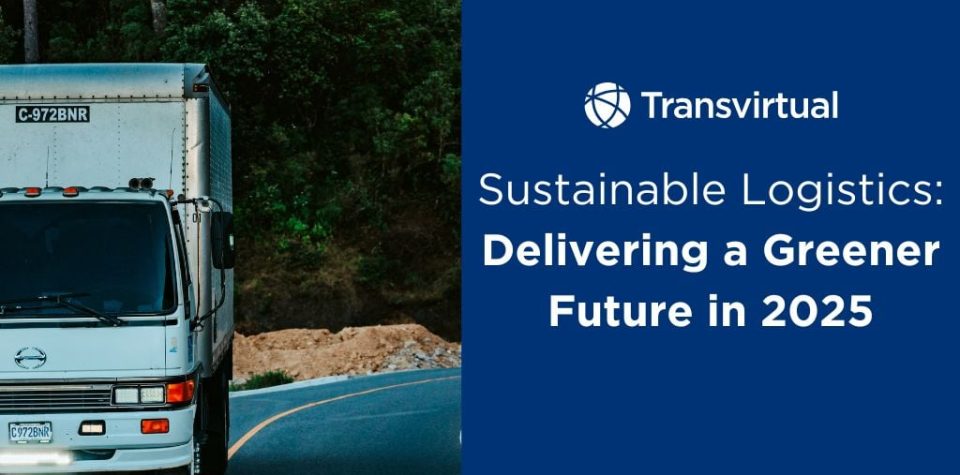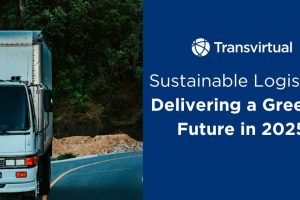As climate change and environmental degradation becomes more apparent, adopting sustainable logistics practices is more crucial than ever.
From a business perspective, customers (particularly the younger generation) have now become more environmentally aware, and they’re underscoring the need for more sustainable logistics operations. Traditional logistics often involve complex global supply chains that can lead to significant environmental issues like deforestation, habitat destruction, and pollution. And let’s be honest, we only have one Earth, so why not prioritise environmental responsibility?
That said, how exactly do you prep your business for a more sustainable future?
If you’re ready to implement sustainable logistics into your 2025 strategy, here are some ideas.
What is Sustainable Logistics?
Sustainable logistics is all about weaving environmental responsibility into every part of the logistics process—from procurement to final delivery. It’s about finding smarter ways to reduce the environmental impact of operations while keeping things efficient and cost-effective. By focusing on the entire supply chain, including the end-of-life stage, businesses can balance between running smoothly and caring for the planet.
Besides, adopting sustainable logistics practices helps reduce carbon footprints, cut greenhouse gas emissions, and create a more sustainable future for everyone.
Benefits of Sustainable Logistics
Implementing sustainable logistics practices offers numerous benefits, including:
-
Reduced Carbon Footprint and Greenhouse Gas Emissions: By optimizing routes, using fuel-efficient vehicles, and adopting renewable energy sources, companies can significantly lower their carbon footprint.
-
Improved Supply Chain Efficiency and Reduced Waste: Sustainable logistics practices streamline operations, reduce waste, and enhance overall supply chain efficiency.
-
Increased Social Responsibility and Reputation: Companies that prioritize sustainability demonstrate their commitment to environmental responsibility, which can enhance their reputation and social standing.
-
Cost Savings and Improved Bottom Line: While there may be initial costs, sustainable logistics practices often lead to long-term savings through reduced fuel and energy consumption.
-
Improved Customer Satisfaction and Loyalty: Consumers are increasingly valuing sustainability, and companies that adopt green logistics practices can attract and retain environmentally conscious customers.
-
Enhanced Brand Image and Reputation: A commitment to sustainability can boost a company’s brand image, making it more attractive to both customers and investors.
By embracing sustainable logistics, businesses not only contribute to a greener planet but also enjoy tangible benefits that can improve their bottom line and customer relationships.
Challenges in Implementing Sustainable Logistics
Implementing sustainable logistics can be challenging, and some of the most common challenges include:
-
High Upfront Costs and Investment: Transitioning to sustainable practices often requires significant initial investment in new technologies and infrastructure.
-
Lack of Awareness and Education Among Employees and Stakeholders: Ensuring that everyone involved understands the importance and benefits of sustainable logistics is crucial for successful implementation.
-
Difficulty in Measuring and Tracking Progress: Monitoring the impact of sustainable practices can be complex, requiring robust tracking and reporting systems.
-
Resistance to Change and Cultural Barriers: Change can be met with resistance, especially in established organizations with long-standing practices.
-
Limited Resources and Budget Constraints: Smaller companies may struggle with the financial and resource demands of implementing sustainable logistics.
Organizations must be willing to invest time and resources to overcome these challenges and implement sustainable logistics practices. By doing so, they can pave the way for a more sustainable future.
Green Logistics: The Art of Reducing Your Carbon Footprint
1. Reduce carbon emissions and fuel consumption
In Australia, the emissions produced by the transport industry account for around 18% of the country’s greenhouse gases. A significant portion of these emissions is created by the logistics industry.
Of course, moving goods, freight, services, and documents around our cities, towns, and countryside is a vital part of Australia’s economy. So finding ways to reduce fuel consumption and emissions while still keeping the wheels turning is a challenge…but not an impossible one.
-
Transport Alternatives: Hybrid and electric vehicles are becoming increasingly common for short and medium delivery runs as EV technology improves. They emit fewer emissions, are quieter, and offer responsive handling.
-
Fuel-Efficient Vehicles: Modern fuel-efficient trucks and vans, including hydrogen-powered options, reduce consumption and emissions, providing practical solutions for diverse delivery needs.
-
Advanced Route Planning Software: Smart routing software optimizes delivery paths, reducing fuel use by up to 30%. It accounts for traffic and time windows, improving efficiency and cutting costs.
2. Implementing Green Logistics in Your Warehouse
Many logistics companies are now also taking steps to reduce the energy consumed and improve the efficiency of the operations of their warehouse premises.
Key Initiatives for Green Logistics
-
Energy-Efficient Systems: Install energy-efficient lighting, heating, and cooling systems to minimize power consumption.
-
Energy Management Technologies: Use monitoring systems to track and optimize energy use in real time.
-
Automation and Data Analytics: Streamline logistics operations with automation and data-driven insights, reducing energy waste.
-
Sustainable Packaging: Transition to eco-friendly materials and reduce excess packaging to minimize environmental impact.
-
Waste Management: Implement recycling programs and reduce landfill contributions by managing waste efficiently.
3. Circular Supply Chains
Circular supply chains are a relatively new concept in the Australian logistics industry but are becoming increasingly popular as companies seek to reduce their environmental impact.
A circular supply chain is a closed-loop system where resources and materials are continuously reused or recycled, rather than discarded. This approach can significantly reduce waste and emissions, and can also help companies save money on resources and materials.
4. Automate
The days of fax machine, paper trails, telephone calls and signed dockets are gone. These days, everything in an efficient logistics business can be controlled and overseen electronically. This not only gives business owners more oversight into how their logistics are working. It also provides opportunities to reduce waste, set up and operate more efficient delivery routes, and keep wastage to a minimum.
For example, software can be used to implement more sustainable practices in the following areas of the supply chain:
-
Transport management systems. Software that can oversee and monitor the movement of your vehicles is an important factor in reducing the greenhouse emissions of your fleet. By saving time and fuel, fleet management and route optimisation software can significantly improve the efficiency of your delivery network.
-
Warehouse Management Systems. Being able to easily store consignments in the correct part of a warehouse, and efficiently find these goods when required, means fewer movements within your warehouse by forklifts.
-
Third Party Logistics. By helping companies fulfil their orders more efficiently and with fewer picking errors, a software system for 3PL operators can avoid expensive return journeys and ensure fewer trips by courier and freight vehicles.
-
Freight Consolidation Systems. Being able to match up consignments going to the same destination with different operators is a highly efficient way to lessen the number of vehicles on the road. Freight consolidation is a strategy that logistics software can easily implement and monitor.
Innovations in Sustainable Logistics
The logistics industry is witnessing significant innovations aimed at reducing its environmental impact. Some of the key innovations include:
-
Electric and Hybrid Vehicles: These vehicles produce fewer emissions and are becoming more viable for various delivery needs.
-
Alternative Fuels: Biofuels and compressed natural gas offer cleaner alternatives to traditional fossil fuels.
-
Autonomous Vehicles and Drones: These technologies can optimize delivery routes and reduce fuel consumption.
-
Renewable Energy Solutions: Solar and wind power can be used to power logistics facilities, reducing energy consumption and greenhouse gas emissions.
-
Sustainable Packaging Materials and Designs: Eco-friendly packaging reduces waste and the environmental impact of logistics operations.
-
Advanced Route Optimization Technologies: These tools help in planning the most efficient routes, cutting down on fuel use and emissions.
These innovations can help reduce fuel consumption, energy consumption, and greenhouse gas emissions, making logistics operations more sustainable and environmentally responsible. By staying at the forefront of these advancements, companies can lead the way in creating a more sustainable future for the logistics industry.
Come on… Keep it Green!
Sustainability is now an important issue in the Australian Logistics industry. Delivery companies increasingly recognize the importance of reducing their environmental footprint. Complex global supply chains can contribute to environmental degradation, highlighting the need for sustainable logistics practices. By investing in new technologies and processes and working together with consumers and the government, the logistics industry can play a significant role in reducing the impact of climate change, and environmental degradation.
Of course, there are challenges associated with implementing sustainable practices within the logistics industry. One of the most significant of these is the cost of transitioning to new processes and technologies. But although the upfront costs can be significant, ultimately many sustainable solutions will save your company money.
Do it for your customers
Consumers are also becoming more conscientious about sustainability and the environmental impact of the things that they buy and have delivered to them. This means that companies that are able to prioritize sustainability can gain a competitive advantage over those that do not. Furthermore, consumers are increasingly willing to pay a premium for products that are sustainably sourced and delivered using logistics practices that are sustainable and green.
By reducing emissions, energy consumption and waste, logistics companies can play a significant role in reducing the impact of climate change. And the bottom line is that you can save money AND improve your reputation with your customers. That alone is worth going green.


